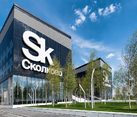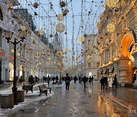Mausoleum and Necropolis
Lenin's Tomb (Mausoleum)
One of the most popular destinations for excursions among my foreign guests is Lenin's Mausoleum - a monument-tomb on Red Square near the Kremlin wall in Moscow. It is here the body of the world-famous Russian statesman and political figure, a revolutionary, one of the organizers of the October Revolution in Russia is buried. The flow of people seeking to see the leader never dries
Now existing Mausoleum is the third construction of reinforced concrete, with brick walls and lined with granite, decorated with marble and porphyry, built in the years 1929-1930 by the architect Shchusev. The mausoleum is built in the form of a stepped pyramid, and, as a tomb, is similar to the early Egyptian pyramids, and also similar to some of the ziggurats. There are the lobby and a mourning hall with an area of 1000 m ² inside the building. New guest podiums were built, graves near the Kremlin wall were decorated in 1930. Lenin's body was evacuated to Tyumen during the Second World War, and returned to his homeland in 1945. In the 1953-1961 year next to Lenin's body in the mausoleum the body of Stalin lied. However, later it was buried.
Due to the fact that many attempts to damage the sarcophagus, where is the body of Lenin, as well as to do harm to the body were committed the bulletproof sarcophagus was installed in the Mausoleum in 1973. Until 1995, the Mausoleum was used as a platform for government leaders to appeal to people during important events, festivals and parades. With the opening of Victory Park on Poklonnaya Hill, this practice ceased and the celebration and appeals of the leaders moved there.
Currently, the Mausoleum is open to access every Tuesday, Wednesday, Thursday and Saturday from 10 AM to 13 PM. The entrance to the Mausoleum and the graves in the Kremlin wall is through a checkpoint at the St. Nicholas tower, where you are checked with the metal detector. Carrying photo and video equipment, mobile phones with a camera is forbidden while visiting the mausoleum. You are prohibited to bring bags, backpacks, large metal objects and bottles with a liquid. You will be offered to leave them in a paid camera store in the building of the Historical Museum. Inside the Mausoleum you should keep silence, not stop at the grave, and make a semicircle around the sarcophagus. Men should remove hats.
Nowadays they are debating about whether to bury Lenin's body in the ground or to consider mausoleum the tomb and to remain Lenin there, as relics of saints.
Necropolis near the Kremlin wall
During the same trip Necropolis near the Kremlin wall is offered to your attention. It is the memorial cemetery at the Moscow Red Square near the wall and inside the wall (that serves as columbarium for urns with ashes) of the Moscow Kremlin. At this place outstanding leaders (mostly political and military) are buried. Some foreign Communists (John Reed, Sen Katayama, Clara Zetkin) were buried here in the 1920-1930.
Necropolis began to form s in November 1917 with a communal grave. At first there were buried 240 people - victims of the October Revolution of 1917 in Moscow, who died fighting for the Bolsheviks. Until 1927, in communal graves near the Kremlin wall fighters of the revolution, died at different times a natural death or killed together with disasters were buried. There are 15 common graves near the Kremlin wall; more than 300 people are buried there.
Later Necropolis was replenished by two types of graves: a particularly prominent figures of the Party and government, buried without cremation near the wall (Frunze, Dzerzhinsky, Zhdanov, Voroshilov, Budyonny, Andropov, Chernenko) and the urn with the ashes of cremated figures immured in the wall under commemorative plates (Kirov , Kuibyshev, Gorky, Ordzhonikidze). There are 114 such urns with ashes. There are urns with ashes of outstanding airmen, perished astronauts, major scientists in the Kremlin Wall in addition to the party and state leaders of the USSR. Politicians, who were in disgrace at the time of death, are not buried near the Kremlin walls (Khrushchev, Mikoyan and Podgorny were buried in the Novodevichy cemetery).
The last buried near the Kremlin wall man was Konstantin Chernenko (March 1985). The latest man, whose ashes were placed in the Kremlin wall, was Ustinov, dead in December 1984, - the Soviet military leader.
Flags made of granite, marble slabs on the wreaths, vases for flowers are used in design of Necropolis. Along the graves blue spruce are planted.
Tours to Necropolis and Mausoleum allows to look at the history of the Russian Federation and the Soviet Union closer, to learn more about the life and the fate of the leaders, defining not only the history of their state, but also influencing on world politics and economics. Journey to the places of their burial can pay tribute to their talent and outstanding abilities. Acquainted with the leaders which determined the destiny of the country more than half a century, you can better understand the soul of the Soviet people, their old ideals and aspirations. This is a kind of a cemetery of communist ideology of the Soviet Union.
Duration : 1 hour. But this time may vary depending on the size of the queue to the Mausoleum.
Previous
Moscow Metro
About Me in Short

My name's Arthur Lookyanov, I'm a private tour guide, personal driver and photographer in Moscow, Russia. I work in my business and run my website Moscow-Driver.com from 2002. Read more about me and my services, check out testimonials of my former business and travel clients from all over the World, hit me up on Twitter or other social websites. I hope that you will like my photos as well.
See you in Moscow!




